#Process on an image processed by Gerald - Enhancement of colors
Explore tagged Tumblr posts
Text
A recent image of Jupiter captured by Juno spacecraft.
Process on an image processed by Gerald - Enhancement of colors
NASA / JPL / SwRI / MSSS / Gerald Eichstädt / Thomas Thomopoulos
More: missionjuno.swri.edu/junocam/proces…

#nasa#nasa photos#nasa jpl#jpl#SwRI#msss#Gerald Eichstädt#Thomas Thomopoulos#Process on an image processed by Gerald - Enhancement of colors#More: missionjuno.swri.edu/junocam/proces…#jupiter#captured by Juno spacecraft#cosmos#Unknown cosmos and unexplored space#de tot#xpuigc#xpuigc bloc
18 notes
·
View notes
Text

Image captured by Juno during its 66th perijove, then further processed with color enhancement by Gerald Eichstädt and Thomas Thomopoulos
NASA / JPL / SwRI / MSSS / Gerald Eichstädt / Thomas Thomopoulos CC BY 3.0
11 notes
·
View notes
Photo

"Image captured by Juno during its 66th perijove, then further processed with color enhancement by Gerald Eichstädt and Thomas Thomopoulos. NASA / JPL / SwRI / MSSS / Gerald Eichstädt / Thomas Thomopoulos CC BY 3.0"
0 notes
Text
You won't believe these 10 incredible photos are pictures of Earth
https://sciencespies.com/space/you-wont-believe-these-10-incredible-photos-are-pictures-of-earth/
You won't believe these 10 incredible photos are pictures of Earth

The Landsat project, a joint venture between NASA and the US Geological Survey, is the longest continuous space-based record of Earth in existence. A total of eight Landsat satellites have been launched into space since 1972, with a ninth set to launch in September.
In that time, the satellites have captured more than 9 million images of the planet’s surface, which have been used in more than 18,000 scientific papers, according to NASA’s Earth Observatory.
To celebrate the upcoming 50th anniversary of the Landsat project, the Earth Observatory is running a public competition to choose the best Landsat pictures of all time.
People can pick their favorites from 32 final images – so that’s exactly what we’ve done.
Winds trigger pond growth

The Atchafalaya Delta. (Joshua Stevens/NASA Earth Observatory)
This striking image of the Atchafalaya Delta in Louisiana was taken by Landsat 8 on 1 December, 2016.
It is a false-color image, meaning that the colors have been altered, which “emphasizes the difference between land and water, while allowing viewers to observe waterborne sediment,” according to the Earth Observatory.
It is one of 10,000 Landsat images of the region taken between 1982 and 2016, which were used in a study published in Geophysical Research Letters that looked at the role wind plays in pond expansion on the Mississippi River Delta Plain.
Where the dunes end

Namib-Naukluft Park. (Joshua Stevens/NASA Earth Observatory)
This image, captured by Landsat 8 on 13 November 2019, shows the striking color contrast between the Namib Sand Sea, the world’s only coastal desert, covering more than 10,000 square miles (26,000 square kilometers), and the rocky mountains of the Namib-Naukluft Park, both in Namibia.
The sand appears a reddish-orange color due to the presence of iron oxide. The Kuiseb River, which is prone to flooding, stops the sand from spilling over into the mountains, according to the Earth Observatory.
Yukon-Kuskokwim in colorful transition

The Yukon-Kuskokwim Delta. (Joshua Stevens/NASA Earth Observatory)
This image of the Yukon-Kuskokwim Delta, where the Yukon River spills into the Bering Sea in Alaska, was taken on 19 May 2021, by Landsat 8. The colors on land have been enhanced in this photo: Green highlights the area of live vegetation; yellow is bare ground; and light brown is dead vegetation.
“The Yukon Delta is an exceptionally vivid landscape, whether viewed from the ground, from the air or from low-Earth orbit,” Gerald Frost, a scientist at ABR, Inc – Environmental Research and Services in Alaska, told the Earth Observatory.
From Russia with questions

The Markha River. (Joshua Stevens/NASA Earth Observatory)
Landsat 8 captured this photo of bizarre ripples in the hills surrounding the Markha River in northern Russia on 29 October 2020. The alternating light and dark stripes are visible throughout the year but are more pronounced in winter.
Scientists aren’t exactly sure why the pattern exists. It could have emerged because of the constant freezing and melting of permafrost or due to some kind of unique erosion from rainfall or snowmelt, but NASA remains unsure, Live Science previously reported.
Ginseng farms in northern China

Farmland in Heilongjiang province. (Joshua Stevens/NASA Earth Observatory)
On 25 September 2017, Landsat 8 captured this image of blue, purple and yellow structures covering large areas of farmland in Heilongjiang province in northeastern China.
The structures are plastic shade covers used to grow ginseng – a slow-growing root plant that looks very similar to ginger but can’t survive in direct sunlight. In many Asian countries, ginseng is believed to have a wide range of medicinal properties, and farming the plant has become a multi-billion dollar business, according to the Earth Observatory.
Painting Pennsylvania hills

Tectonic plates in central Pennsylvania. (Joshua Stevens/NASA Earth Observatory)
This impressive image combines a satellite image of folded mountains – warped mountains formed at the boundary between two tectonic plates - in central Pennsylvania, taken by Landsat 8 on 9 November, 2020, with a digital elevation model to highlight the topography of the area.
The mountains are part of a unique geological region of the Appalachian Mountains, known as the Valley and Ridge province, which stretches from New York to Alabama. As well as showing off the unusual shapes of the mountains, this natural-color image also reveals the autumnal palette of colors created as leaves turn red and begin to fall from deciduous trees, according to the Earth Observatory.
Jason and the Bloomonauts

(Joshua Stevens/NASA Earth Observatory)
This stunning natural-color image of an algal bloom surrounding the western Jason Islands, an archipelago in the South Atlantic Ocean, was taken by Landsat 8 on 18 October, 2020.
The milky blue swirls are caused by the rapid growth of photosynthetic algae, which thrive in the nutrient-rich waters that have been enriched by the Malvinas Current – a spin-off of the Circumpolar Current of the Southern Ocean, which draws up nutrients from the deep ocean, according to the Earth Observatory.
Lake Natron

(Joshua Stevens/NASA Earth Observatory)
This striking aerial photo of the blood-red Lake Natron in Tanzania was taken by Landsat 8 on 6 March 2017. Lake Natron is an alkaline lake. The dramatic color is fueled by molten mixtures of sodium carbonate and calcium carbonate salts from nearby volcanoes that enter the water via hot springs.
With temperatures averaging 104 degrees Fahrenheit (40 degrees Celsius) and less than 19.7 inches (500 millimeters) of rainfall a year, it is one of the harshest environments on Earth, according to the Earth Observatory.
Icy art in the Sannikov Strait

(Lauren Dauphin/NASA Earth Observatory)
This fascinating photo of the Sannikov Strait – a body of water sandwiched between the New Siberian Islands north of mainland Russia – was taken by Landsat 8 on 5 June 2016.
The strait connects the Laptev Sea to the west with the Siberian Sea to the east; the strait remains covered in ice for the majority of the year, Live Science previously reported. This photo shows the ice sheet breaking apart during the summer melt and creating a picturesque panorama of icy puzzle pieces.
Where batteries begin

(Lauren Dauphin/NASA Earth Observatory)
This colorful array of cuboids found in the Salar de Atacama – a salt flat surrounded by mountains in Chile – is actually the world’s largest lithium plant, photographed by Landsat 8 on 4 November 2018.
Lithium is the main component of batteries needed to power our cars, cellphones, laptops and other rechargeable gadgets.
This plant pumps lithium-rich brine from below the surface and diverts it into evaporation pools, where the sun evaporates the water away, leaving pure lithium. The different colors are a result of the varying stages of the evaporating process, according to the Earth Observatory.
This article was originally published by Live Science. Read the original article here.
#Space
3 notes
·
View notes
Photo

2019 April 15
Enhanced: The Dolphin Cloud on Jupiter Image Credit: NASA, Juno, SwRI, MSSS; Processing: Gerald Eichstädt & Avi Solomon
Explanation: Do you see the dolphin-shaped cloud on Jupiter? The cloud was visible last year during perijove 16, the sixteenth time that NASA's robotic spacecraft Juno passed near Jupiter since it arrived in mid-2016. During each perijove, Juno passes near a slightly different part of Jupiter's cloud tops. The dolphin shape may be surprising but is not scientifically significant -- clouds on Jupiter and Earth are constantly shifting and can temporarily mimic many familiar shapes. The cloud appears in Jupiter's South Temperate Belt (STB), a band of dark and dropping clouds that rings the planet and also contains Oval BA, dubbed Red Spot Jr. The featured image was digitally processed to enhance color and contrast. Juno's next swoop near Jupiter -- perijove 20 -- will occur on late May.
��� Source: apod.nasa.gov/apod/ap190415.html
119 notes
·
View notes
Photo

APOD: 2019 April 15 - Enhanced: The Dolphin Cloud on Jupiter ⠀ ⠀ Do you see the dolphin-shaped cloud on Jupiter? The cloud was visible last year during perijove 16, the sixteenth time that NASA's robotic spacecraft Juno passed near Jupiter since it arrived in mid-2016. During each perijove, Juno passes near a slightly different part of Jupiter's cloud tops. The dolphin shape may be surprising but is not scientifically significant -- clouds on Jupiter and Earth are constantly shifting and can temporarily mimic many familiar shapes. The cloud appears in Jupiter's South Temperate Belt (STB), a band of dark and dropping clouds that rings the planet and also contains Oval BA, dubbed Red Spot Jr. The featured image was digitally processed to enhance color and contrast. Juno's next swoop near Jupiter -- perijove 20 -- will occur on late May.⠀ ⠀ Image Credit: NASA, Juno, SwRI, MSSS; Processing: Gerald Eichstädt & Avi Solomon⠀ NASA APOD (https://go.nasa.gov/2UWoQp4) via Instagram http://bit.ly/2DdSnQR
19 notes
·
View notes
Text
Juno’s Latest Flyby of Jupiter Captures Two Massive Storms
NASA - JUNO Mission logo. Jan. 18, 2019
This image of Jupiter’s turbulent southern hemisphere was captured by NASA’s Juno spacecraft as it performed its most recent close flyby of the gas giant planet on Dec. 21, 2018. This new perspective captures the notable Great Red Spot, as well as a massive storm called Oval BA. The storm reached its current size when three smaller spots collided and merged in the year 2000. The Great Red Spot, which is about twice as wide as Oval BA, may have formed from the same process centuries ago. Juno captured Oval BA in another image earlier on in the mission on Feb. 7, 2018. The turbulent regions around, and even the shape of, the storm have significantly changed since then. Oval BA further transformed in recent months, changing color from reddish to a more uniform white. Juno took the three images used to produce this color-enhanced view on Dec. 21, between 9:32 a.m. PST (12:32 p.m. EST) and 9:42 a.m. PST (12:42 p.m. EST). At the time the images were taken, the spacecraft was between approximately 23,800 miles (38,300 kilometers) to 34,500 miles (55,500 kilometers) from the planet’s cloud tops above southern latitudes spanning 49.15 to 59.59 degrees.
Juno spacecraft orbiting Jupiter
Citizen scientists Gerald Eichstädt and Seán Doran created this image using data from the spacecraft’s JunoCam imager. JunoCam’s raw images are available for the public to peruse and to process into image products at: http://missionjuno.swri.edu/junocam. More information about Juno is at: http://www.nasa.gov/juno and http://missionjuno.swri.edu. Image, Animation, Text, Credits: NASA/Tony Greicius/JPL-Caltech/SwRI/MSSS/Gerald Eichstädt/Seán Doran. Greetings, Orbiter.ch Full article
51 notes
·
View notes
Photo


Juno’s Latest Flyby of Jupiter Captures Two Massive Storms
01.17.19 Juno’s Latest Flyby of Jupiter Captures Two Massive Storms (top image) This image of Jupiter’s turbulent southern hemisphere was captured by NASA’s Juno spacecraft as it performed its most recent close flyby of the gas giant planet on Dec. 21, 2018.
This new perspective captures the notable Great Red Spot, as well as a massive storm called Oval BA. The storm reached its current size when three smaller spots collided and merged in the year 2000. The Great Red Spot, which is about twice as wide as Oval BA, may have formed from the same process centuries ago.
Juno captured Oval BA in another image (lower image) earlier on in the mission on Feb. 7, 2018. The turbulent regions around, and even the shape of, the storm have significantly changed since then. Oval BA further transformed in recent months, changing color from reddish to a more uniform white.
Juno took the three images used to produce this color-enhanced view on Dec. 21, between 9:32 a.m. PST (12:32 p.m. EST) and 9:42 a.m. PST (12:42 p.m. EST). At the time the images were taken, the spacecraft was between approximately 23,800 miles (38,300 kilometers) to 34,500 miles (55,500 kilometers) from the planet’s cloud tops above southern latitudes spanning 49.15 to 59.59 degrees.
Citizen scientists Gerald Eichstädt and Seán Doran created this image using data from the spacecraft’s JunoCam imager.
JunoCam’s raw images are available for the public to peruse and to process into image products at: http://missionjuno.swri.edu/junocam
More information about Juno is at: http://www.nasa.gov/juno and http://missionjuno.swri.edu
19 notes
·
View notes
Text
Solar System: Things to Know This Week
Our Juno mission has been exploring Jupiter since July 2016 with a special passenger on board: JunoCam, an instrument designed to take spectacular close-up color images of the largest planet in our solar system. From the raw images, citizen scientists have processed a range of beautiful photographs that highlight Jupiter's features, even turning them into works of art. Below, 10 stunning images JunoCam has given us over the past year.
1. Jovian tempest.

This color-enhanced image of a massive, raging storm in Jupiter's northern hemisphere was captured by our Juno spacecraft during its ninth close flyby on Oct. 24, 2017. The storm is rotating counter-clockwise with a wide range of cloud altitudes, and the darker clouds are expected to be deeper in the atmosphere than the brightest clouds.
2. A southern stunner.
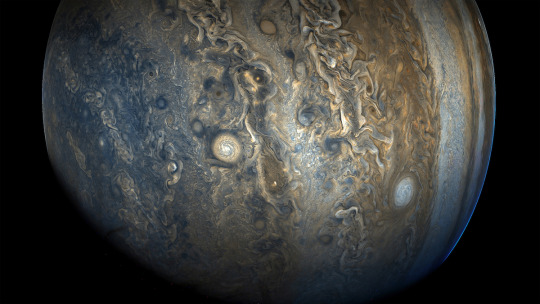
Jupiter's southern hemisphere shows off in beautiful detail in this image taken on Oct. 24, 2017. The color-enhanced view captures one of the white ovals in the "String of Pearls," one of eight massive rotating storms at 40 degrees south latitude on the gas giant planet.
3. Dreaming in color.
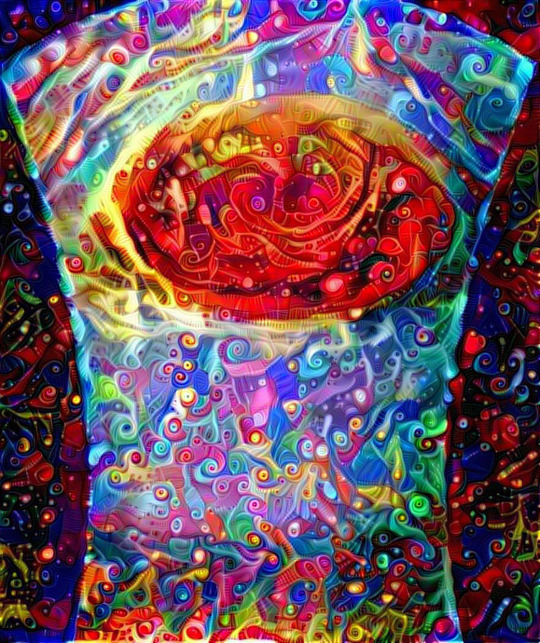
Artist Mik Petter created this unique digital piece using data from the JunoCam. The art form, known as fractals, uses mathematical formulas to create an infinite variety of form, detail, color and light. The original JunoCam image was taken on July 10, 2017.
4. Jovian moon shadow.
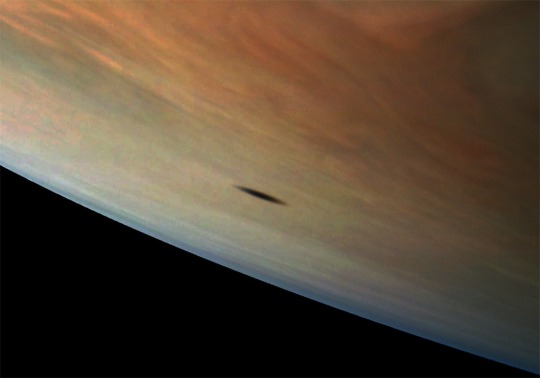
Jupiter's moon Amalthea casts a shadow on the gas giant planet in this image taken on Sept. 1, 2017. The elongated shape of the shadow is a result of both the location of the moon with relation to Jupiter in this image as well as the irregular shape of the moon itself.
5. 95 minutes over Jupiter.

Once every 53 days, Juno swings close to Jupiter, speeding over its clouds. In about two hours, the spacecraft travels from a perch over Jupiter's north pole through its closest approach (perijove), then passes over the south pole on its way back out. This sequence shows 11 color-enhanced images from Perijove 8 (Sept. 1, 2017) with the south pole on the left (11th image in the sequence) and the north pole on the right (first image in the sequence).
6. Soaring high.
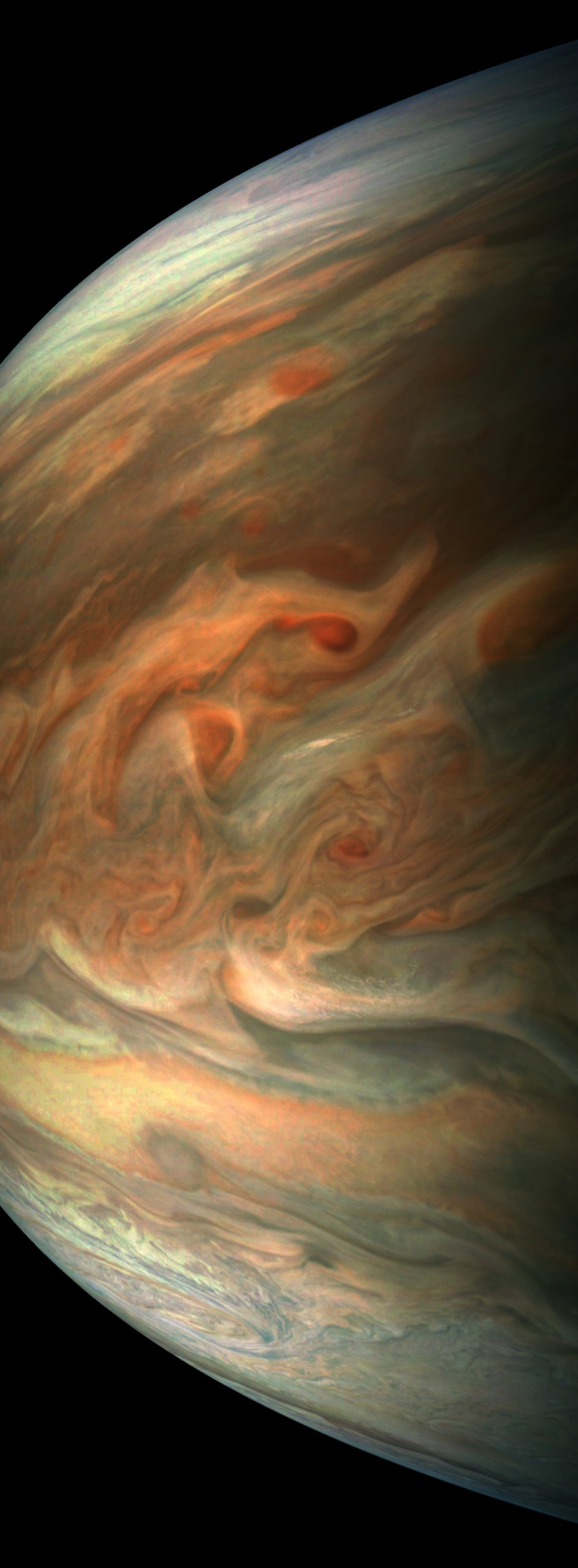
This striking image of Jupiter was taken on Sept. 1, 2017 as Juno performed its eighth flyby. The spacecraft was 4,707 miles (7,576 kilometers) from the tops of the clouds of the planet at a latitude of about -17.4 degrees. Noteworthy: "Whale's Tail" and "Dan's Spot."
7. In true color.
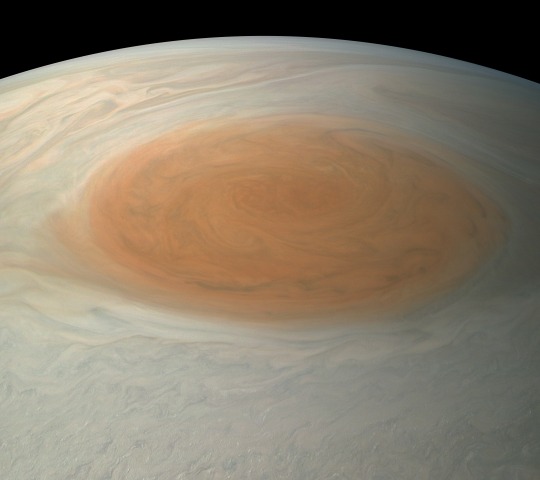
This true-color image offers a natural color rendition of what the Great Red Spot and surrounding areas would look like to human eyes from Juno's position. The image was taken on July 10, 2017 as the Juno spacecraft performed its seventh close flyby of Jupiter.
8. The 'face' of Jupiter.
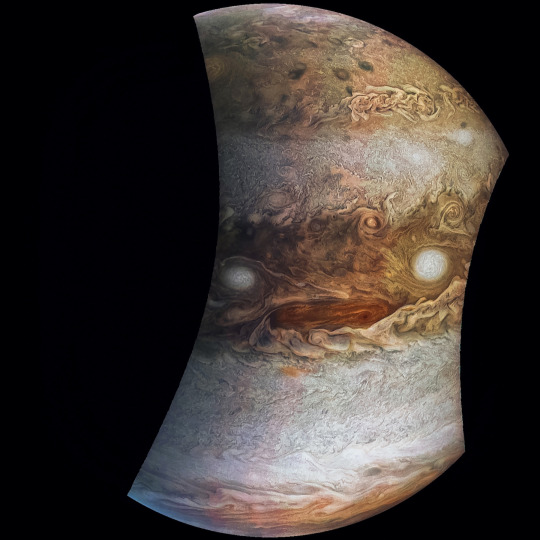
JunoCam images aren't just for art and science—sometimes they're created for a good chuckle. This image, processed by citizen scientist Jason Major, is titled "Jovey McJupiterface." By rotating the image 180 degrees and orienting it from south up, two white oval storms turn into eyeballs, and the "face" of Jupiter is revealed. The original image was taken by the Juno spacecraft on May 19, 2017.
9. Bands of clouds.
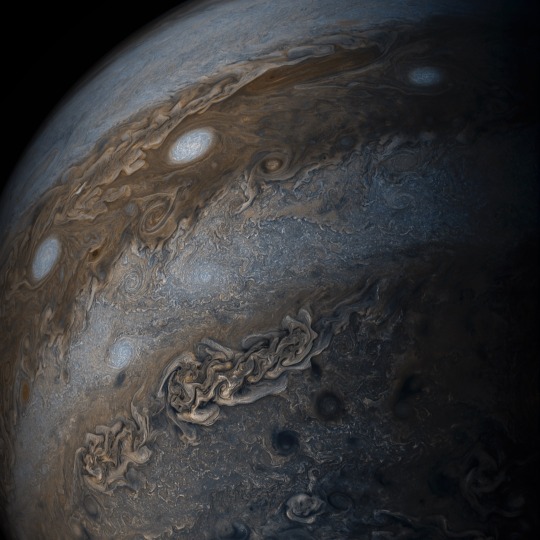
This enhanced-color image of Jupiter's bands of light and dark clouds was created by citizen scientists Gerald Eichstädt and Seán Doran. Three of the white oval storms known as the "String of Pearls" are visible near the top of the image. Each of the alternating light and dark atmospheric bands in this image is wider than Earth, and each rages around Jupiter at hundreds of miles (kilometers) per hour. The lighter areas are regions where gas is rising, and the darker bands are regions where gas is sinking. Juno captured the image on May 19, 2017.
10. The edge.

This enhanced-color image of a mysterious dark spot on Jupiter seems to reveal a Jovian "galaxy" of swirling storms. Juno captured this image on Feb. 2, 2017 and citizen scientist Roman Tkachenko enhanced the color to bring out the rich detail in the storm and surrounding clouds. Just south of the dark storm is a bright, oval-shaped storm with high, bright, white clouds, reminiscent of a swirling galaxy. As a final touch, he rotated the image 90 degrees, turning the picture into a work of art.
To learn more about the Juno mission at Jupiter, visit: www.nasa.gov/juno.
Follow the Juno mission on Facebook, Instagram and Twitter.
Make sure to follow us on Tumblr for your regular dose of space: http://nasa.tumblr.com.
#nasa#juno#space#spacecraft#jupiter#planets#solarsystem#planet#science#clouds#swirls#pictures#junocam#gasgiant
5K notes
·
View notes
Photo

Jovian Jet Stream by NASA's Marshall Space Flight Center See a jet stream speeding through Jupiter’s atmosphere in this new view taken by NASA’s Juno spacecraft. The jet stream, called Jet N2, was captured along the dynamic northern temperate belts of the gas giant planet. It is the white stream visible from top left to bottom right in the image. The color-enhanced image was taken at 10:34 p.m. PST on May 23 (1:34 a.m. EST on May 24), as Juno performed its 13th close flyby of Jupiter. At the time the image was taken, the spacecraft was about 3,516 miles (5,659 kilometers) from the tops of the clouds of the planet at a northern latitude of 32.9 degrees. Citizen scientists Gerald Eichstädt and Seán Doran created this image using data from the spacecraft’s JunoCam imager. JunoCam's raw images are available for the public to peruse and process into image products at: www.missionjuno.swri.edu/junocam Read more NASA Media Usage Guidelines https://flic.kr/p/26GUTkm
85 notes
·
View notes
Text
Getintopc After Effects 2018

Getintopc After Effects 2018
Premiere Pro 2018 Getintopc
Getintopc After Effects 2018 Free
After Effects Cc 2018 Getintopc
5/5(1 vote )
Adobe After Effects CC 2019 16.1 Deliver cinematic visual effects and sophisticated motion graphics using the industry standard for animation and compositing that offers you complete creative. Element 3D is a Fast Open GL 3D object based particle Rendering Engine for After Effects. Create visual effects faster in Adobe® After Effects® CS6 software with Global Performance Cache, which optimizes and keeps your previews so you can beat deadlines instead of waiting for frame. Work with Motion Graphics templates in After Effects Use expressions to create drop-down lists in Motion Graphics templates Work with Master Properties to create Motion Graphics templates.

If you looking on the internet a Photoshop CC 2018 GetIntoPC So, you come to the right place now a day shares with you an amazing application for Photo editing software made by official Adobe Photoshop CC 2018 version its little bit old version but it’s much famous and many features in this version people can demand still is high downloading.
The available portable offline Windows 32-bit and 64-bit set up is Adobe Photoshop CC 2018 v19.0. Adobe Photoshop Creative Cloud 2018 19.0 is a leading software framework of image editing with various tools and solutions to enhance digital photography and edit it. Portable Photoshop CC 2018 can also be downloaded.
Getintopc After Effects 2018
Adobe Photoshop CC 2018 Overview:
Adobe Photoshop CC 2018GetIntoPC is a technical software of image editing that has many resources and a Mercury Graphics Engine. The usefulness of Adobe Photoshop can not be disputed because it is the most common software of image editing and the most popular editing method. GetIntoPC Adobe Photoshop CC 2018 v19.1 provides much amazing functionality like smart auto-correction, HDR processing, Color control, filters, brushes, histogram palettes, and masks, etc. The success of Adobe Photoshop can be measured by the fact that a newly named Photoshoped has been created for the photos. You may make instant photo corrections for the elimination of color aberrations with this software.
Adobe Photoshop has infinite capabilities to modify the photos without losing the performance. It has some amazing features such as intelligent self-correction, HDR lighting, color balance, masking, filters, textures, surface monitoring, and histogram palettes. You could create certain fast adjustments in your photographs with Adobe Photoshop CC 2018 such as the deletion of chromatic aberrations, lens distortions, etc. This software is created for both experts and beginners. Such technology provides sophisticated and nuanced digital imaging devices.
Mills & Boon is a romance imprint of British publisher Harlequin UK Ltd. It was founded in 1908 by Gerald Rusgrove Mills and Charles Boon as a general publisher. Anne Mather, 46 books Charlotte Lamb, 42 books Anne Hampson, 41 books Betty Neels, 38 books Flora Kidd, 34 books Lilian Peake, 32 books Margaret Way, 31 books Janet Dailey, 29 books Rebecca Stratton, 29 books Elizabeth Ashton, 29 books Violet Winspear, 27 books Joyce Dingwell, 27 books Mary Wibberley, 24 books Margaret Pargeter, 22 books. Mills and Boon is the world’s leading publisher of romance fiction and we are happy to tell you that all your favourite romance books are now back with a passion in South Africa. Mills and Boon is distributed by Jonathan Ball Publishers. 2153 downloads 68114 Views 2MB Size Report. The Hard Man Penny Jordan Mills & Boon Harlequin Mills & Boon Ltd Eton House 18-24 Paradise Road Richmond, Surrey, TW9. Gennis Dilemma (Mills & Boon 100th Birthday Collection) An Honourable Rogue (Mills & Boon Historical Romance). Mills and boon romance novels free download pdf. Explore our Free Reads. Every month we select a new title from one of our authors so that you can discover new stories and genres for free. Plus, you can read the first chapter of.
Premiere Pro 2018 Getintopc

Mercury Graphics Engine significantly improves the application’s speed and efficiency while speaking about machine quality. Adobe apps provide endless opportunities for enhancing digital media. Without compromising quality, you can handle the virtual graphics and their smart functionality make it easy for users to instantly fix different problem areas, as well as other choices such as masking, high definition pictures, filters, color control, transitions, histograms, brushes, pallets, and many more. It’s a content-oriented device with many versatile choices that bring your photography to the next stage. you can also check out the Getintopc Windows 10.


Features of Adobe Photoshop CC 2018

Supports almost all existing video formats
High quality and low-resolution HDR quality
3D image design
An animation design that has been added to the new version completely
Display colors with different criteria
Separate colors easily
Multi-color combinations to get the desired color
Effects, filters, incredibly beautiful brushes and many more
Ability to zoom into high-resolution images
Compatibility with other Adobe software such as Adobe After Effects, Adobe Premiere, Adobe Illustrator, Adobe Encore DVD …
Make menus for DVD movie quality
Multi-layered images for professional changes
Full features to apply changes to the image, such as rotate, zoom, resize, change color and …
Full compatibility with Lightroom
Powerful communication with Photoshop between computers and digital devices
Ability to change videos in the frame by frame without the slightest changes in quality
Ultimate quality in printing pages
The ability to rotate images 360 degrees
Change the light angle of images simply and completely custom
Ultra-useful Tab Browsing feature that quickly helps professionals
Compatibility with Adobe Acrobat and popular PDF format
One-touch images with automatic color change – Easily manage menus
New and interesting features for online use
Scale speed using better compatibility with GPU processors
Optimized for 64-bit versions for faster processing
Ultra-easier management of multimedia files
Automatic lens for pictures
Easier selection of the desired part of the image
New and interesting effects including lighting effects in designs
Possibility to rotate part of the images without disrupting the whole photo
Sweet Persian language support
Compatible with various versions of Microsoft Windows operating system
Professional and powerful application for digital imaging
Mercury Graphics Engine for ultimate performance
Industry-standard for graphics editing
Masking, HDR imaging, color management, animations, effects, and more
Accurate selection for cropping and other operations
Layer control tools with palettes, brushes, and histogram
Auto-correction and content-aware application
Managing colors, painting, drawing and other such features
A professional image editing application equipped with loads of tools.
Got endless possibilities for manipulating the images.
No compromise on the quality of the image.
Got intelligent auto-correction, HDR imaging, color management, and histogram palettes features.
Can make quick corrections on your picture like removing the chromatic aberrations, vignetting and lens distortions, etc.
Got HDR imaging and toning by which the tone control can be managed easily.
Much More…………./
Adobe Photoshop CC 2018 Technical Setup Details
Software Full Name: Adobe Photoshop CC 2018
Setup File Name: Adobe_Photoshop_CC_2018_v19.0.0.24821.zip
Full Setup Size: 3.3 GB
Setup Type: Offline Installer / Full Standalone Setup
Compatibility Architecture: 32 Bit (x86) / 64 Bit (x64)
Latest Version Release Added On: 28th Oct 2017
Developers: Adobe
System Requirements For Adobe Photoshop CC 2018
Before you start Adobe Photoshop CC 2018 GetIntoPC free download, make sure your PC meets minimum system requirements.
Getintopc After Effects 2018 Free
Operating System: Windows 7/8/8.1/10
Memory (RAM): 2 GB of RAM required.
Hard Disk Space: 2 GB of free space required.
Processor: Intel Dual Core processor or later.
Adobe Photoshop CC 2018 Free Download
After Effects Cc 2018 Getintopc
For the offline architecture of Windows x86 and x64, click on the link given on the following page. It’s outstanding software for smooth processing and improving digital photography.

0 notes
Photo

From NASA Image of the Day; February 23, 2018:
Time-lapse Sequence of Jupiter’s South Pole
This series of images captures cloud patterns near Jupiter's south pole, looking up towards the planet’s equator.
NASA’s Juno spacecraft took the color-enhanced time-lapse sequence of images during its eleventh close flyby of the gas giant planet on Feb. 7 between 7:21 a.m. and 8:01 a.m. PST (10:21 a.m. and 11:01 a.m. EST). At the time, the spacecraft was between 85,292 to 124,856 miles (137,264 to 200,937 kilometers) from the tops of the clouds of the planet with the images centered on latitudes from 84.1 to 75.5 degrees south.
At first glance, the series might appear to be the same image repeated. But closer inspection reveals slight changes, which are most easily noticed by comparing the far left image with the far right image.
Directly, the images show Jupiter. But, through slight variations in the images, they indirectly capture the motion of the Juno spacecraft itself, once again swinging around a giant planet hundreds of millions of miles from Earth.
Citizen scientist Gerald Eichstädt processed this image using data from the JunoCam imager.
JunoCam's raw images are available for the public to peruse and process into image products at: www.missionjuno.swri.edu/junocam
More information about Juno is at: https://www.nasa.gov/juno and http://missionjuno.swri.edu
Image credits: NASA/JPL-Caltech/SwRI/MSSS/Gerald Eichstädt
3 notes
·
View notes
Text
Ambrose Akinmusire: on the tender spot of each calloused moment (Blue Note, 2020)

Ambrose Akinmusire: trumpet; Fender Rhodes: Sam Harris: piano; Harish Raghavan: bass; Justin Brown: drums; Genevieve Artadi: vocals (track 3) Jesus Diaz: vocals, percussion (track 1)
Trumpeter Ambrose Akinmusire has been on the scene for over two decades, first debuting with Prelude... For Cora (Fresh Sound, 2008) but really making a splash with his Blue Note debut, When The Heart Emerges Glistening in 2010. For that recording, he enlisted Walter Smith, III on tenor saxophone, pianist Gerald Clayton (soon to make his own Blue Note debut), Harish Raghavan on bass and Justin Brown on drums-- what was immediately apparent on that recording was the striking individual trumpet sound, quite heady writing which shared a lot in common with the jazz tradition both American and European, the provocative, poetic tune titles that also dealt with the experience of being black in America. With on the tender spot of each calloused moment, the trumpeter makes perhaps his deepest statement to date, finding him back in the quartet format that dominated 2017's double disc A Rift in Decorum: Live at the Village Vanguard and eschewing the more album length concept of Origami Harvest last year.
Before anything is said of the music which is excellent, haunting, and relentlessly challenging the album speaks to the trouble social climate that our world is currently in. Not only is the society dealing with COVID-19, but the senselessly brutal May 26. 2020 killing of George Floyd by Minneapolis police officer Derek Chauvin, in which the officer drove a knee into Floyd's neck for an appalling 8:46 and killing him. The riots in direct response to this atrocity have lead America to a breaking point, no longer are people dealing with racial injustice, and with a gleam of hope Americans, black, white, Asian and Latino are joining together to say enough is enough. Akinmusire appears on the cover in a stark black and white portrait, his hair in cornrows, shadow and light playing off each other, bearded, and in a black hoodie, bringing to mind Trayvon Martin. The trumpeter has always aimed to present his music in extremes, on Origami Harvest the use of cliched misogynistic hip hop phrases, at times in completed random places were rendered with an almost darkly humored absurdity, but on the tender spot of each calloused moment serves as a not so frank wake up call to society to look at what it's doing.
For the album which Akinmusire considers a sequel to his initial Blue Note offering, he brings back his long standing quartet. The group includes pianist Sam Harris (not to be confused with 80's Star Search winner and 80's pop, R&B singer) Harish Raghavan on bass, and drummer Justin Brown whom appeared on 2017's A Rift In Decorum, augmented by special guests including Knower's Genevieve Artadi and percussionist Jesus Diaz. The trumpeter presents perhaps his most ambitious social and artistic statement to date, that pulls on subtle touches of contemporary pop production, new music, R&B and the avant garde into a mixture purely his own. While the music does indeed feel a bit similar in tone and mood to When The Heart Emerges Glistening, it draws more upon the uncompromising nature that marked the double live album, which is in no small part to how in tune the quartet is. As they embark on the suite like “Tide of Hyacinth”, they deftly demonstrate how the trumpeter works at extremes. The first section of the three part tune is a busy, roaring collective avant improvisation, the trumpet spattering Jackson Pollack like fragments into the atmosphere, with Raghavan's extended bowing techniques, and Brown's treated cymbals and thwacking dead toms. The second section is more driving, Brown's cymbals acting as flowing waves, with Akinmusire's intense winding melody setting the stage for Harris' piano, focusing on color and texture. The third section throws something that at first seems like a non sequitir, but makes complete sense when one keeps in mind the concept of extremes. The voice of percussionist Jesus Diaz joins the fray, singing in the Yoruba dialect that initially the trumpeter wanted his father to sing. Diaz' section adds a grooving, joyous Afro-Latin element, the 2-3 clave an intriguing feature, and the piece closes on this joyous note. “Yessss” seems to be a reflection on the history of the African American struggle, Akinmusire's varying vocal inflections and deep blues undercurrent lament the seeming progress, but the longing in his tone appears to be saying “What progress have we made really? there's much more to be done”. The gradual solo build over synthesizers and a back beat from Brown's dead snare bring the track into a more contemporary vein reminiscent of D'Angelo, and a nice send off.
“Cynical Sideliners” with Akinmusire on Rhodes, and the child like vocals of Genevieve Artadi, is a bizarre lullaby. The track could be seen as a subtle indictment of those who are sitting and complaining about the current social upheavals but ultimately doing nothing. Artadi delivers the lyrics with a detached naivete that is disconcerting against the pillowy Rhodes chords, but it also is because of this exact mood that makes it such a striking piece on the album. “Mr. Roscoe (consider the simultaneous” is a reflection on the great Art Ensemble of Chicago co founder, multi instrumentalist, Roscoe Mitchell, and in this piece, Akinmusire who was a member of Mitchell's quartet balances the essence of the unique composed and improvised structures the multinstrumentalist oft employed.
Still, Akinmusire's aim through all the music with trademark poetic titling is to reach for the heart. Harish Raghavan's double stops and extended solo set the mood for “Interlude (that get more intense) featuring Harris' tornado of pianism, and another deeply emotional trumpet solo, that finds Akinmusire considering the thematic possibilities of a triplet repeating in morse code as the tumult dies down. What really touches the emotions deeply however is the closing “Hooded Procession (read the names aloud) which continues a series beginning with “My Name is Oscar” on the first Blue Note. The pieces evoke serious thought about the horrors of all the black men and women falling victim to police violence as well as the senseless mass shootings over the past decade. The “Hooded Procession” of the title is almost an answer to that of “a blooming bloodfruit in a hoodie” on Origami Harvest, and the trumpeter's solitary Rhodes chords this time, with no spoken word as the listener thinks of names like Ahmad Arbury, George Floyd, Sandra Bland, Trayvon Martin, Elijah McClain, the list goes on and on is heart wrenching and chilling. The tribute to Roy Hargrove, simply titled “Roy” is also a sobering reminder of one of the greatest trumpeters of the modern era, and the fostering of talent that he so nurtured. Ambrose Akinmusire now carries the mantle for those of his generation.
Sound:
on the tender spot of each calloused moment is very realistic tonally, Akinmusire's trumpet is full of body, with a warm glow. Listening to the album using the Schiit Modius DAC enhances the stereo image, and the Modius' warmer than neutral character is an advantage. On pieces like “4623” which use effects, the bathroom tile type reverb is quite palpable. Occasionally though, Raghavan's bass is so rich in depth of tone that it occasionally fights with Justin Brown's resonant bass drum, in the audio space. Brown's effects treated toms with their thudding attack and dead snare have a particular presence, and Sam Harris' piano is weighty, realistic and accurate.
Concluding thoughts:
Ambrose Akinmusire is a true artist whose work challenges the viewpoints and thoughts of the listener. As an improviser he remains fearless creating lines that grab attention, and with his quartet, he has a band that is so in tune with his aesthetic, that it's clear from the first note it can be no one but Akinmusire, his tone and ideas so distinctive. on the tender spot of each calloused moment is the most realized chapter to date in the trumpeter's discography from his political and societal stance, to the group interplay and impassioned improvisation.
Music: 9/10
Sound: 8/10
Equipment used:
HP Pavilion Laptop
Focal Chorus 716 Floor Standing Speakers
Schiit Modius DAC
Musicbee (for WAV file playback)
youtube
1 note
·
View note
Text
Europe's moon aliens can feed on radioactivity

Scientists assume that Europe, a satellite of the planet Jupiter, is home to an environment conducive to life. In a huge ocean of salt water bacteria that feed on radioactivity could exist, say researchers from the Brazilian synchrotron light laboratory and the University of Sao Paulo. The satellite of the planet Jupiter, Europe is a good candidate for the search for extraterrestrial life close to the Earth. This Jupiter's moon hides under its thick crust of ice, a huge ocean of salt water. In it, life could develop. Scientists have concluded that there are most likely radioactive elements in Europe that can serve as an energy source for microorganisms similar to those found on Earth called Desulforudis audaxviators, reports Science Alert. The anaerobic sulphate-reducing bacteria Desulforudis audaxviator resides in isolated aquatic ecosystems located at a depth of 1.5 to 3 km. It exists independently of other organisms and does not need sunlight. Substances necessary for chemical processes assure the decay of uranium and other radioactive elements. This is the eleventh time Juno has passed near #Jupiter since it arrived in mid-2016. This time-lapse, color-enhanced movie covers about four hours and morphs between 36 JunoCam images processed by Gerald Eichstädt https://t.co/eRPYValM9R pic.twitter.com/eszCaIbqRf - Massimo (@ Rainmaker1973) February 26, 2018 According to scientists, life on the planet Jupiter's satellite can exist under three conditions: the presence of water, a high temperature and the presence of chemical elements necessary to maintain metabolism. According to recent data, the first two factors are likely to exist. However, researchers do not yet know which substances are dissolved in the waters of Jupiter's satellite. Modeling results show that radioactive materials are most likely present on the Europe satellite, as well as on Enceladus. There should be enough of them to support the lives of organizations like the Desulforudis audaxviator. Read the full article
0 notes
Text
Jovian Close Encounter
NASA - JUNO Mission logo. Nov. 8, 2018
A multitude of magnificent, swirling clouds in Jupiter's dynamic North North Temperate Belt is captured in this image from NASA's Juno spacecraft. Appearing in the scene are several bright-white “pop-up” clouds as well as an anticyclonic storm, known as a white oval. This color-enhanced image was taken at 1:58 p.m. PDT on Oct. 29, 2018 (4:58 p.m. EDT) as the spacecraft performed its 16th close flyby of Jupiter. At the time, Juno was about 4,400 miles (7,000 kilometers) from the planet's cloud tops, at a latitude of approximately 40 degrees north. Citizen scientists Gerald Eichstädt and Seán Doran created this image using data from the spacecraft's JunoCam imager. JunoCam's raw images are available for the public to peruse and to process into image products at: http://missionjuno.swri.edu/junocam. More information about Juno is at: http://www.nasa.gov/juno and http://missionjuno.swri.edu. Image, Text, Credits: NASA/Tony Greicius/JPL-Caltech/SwRI/MSSS/Gerald Eichstädt/Seán Doran. Greetings, Orbiter.ch Full article
77 notes
·
View notes
Photo

Jupiter’s Clouds
NASA’s Juno spacecraft was a little more than one Earth diameter from Jupiter when it captured this mind-bending, color-enhanced view of the planet’s tumultuous atmosphere.
Jupiter completely fills the image, with only a hint of the terminator (where daylight fades to night) in the upper right corner, and no visible limb (the curved edge of the planet).
Juno took this image of colorful, turbulent clouds in Jupiter’s northern hemisphere on December 16, 2017 at 9:43 a.m. PST (12:43 p.m. EST) from 8,292 miles (13,345 kilometers) above the tops of Jupiter’s clouds, at a latitude of 48.9 degrees.
The spatial scale in this image is 5.8 miles/pixel (9.3 kilometers/pixel).
Citizen scientists Gerald Eichstädt and Seán Doran processed this image using data from the JunoCam imager.
JunoCam’s raw images are available for the public to peruse and process into image products at: www.missionjuno.swri.edu/junocam
~ SciTechDaily
Image credits: NASA/JPL-Caltech/SwRI/MSSS/Gerald Eichstädt/Seán Doran
13 notes
·
View notes